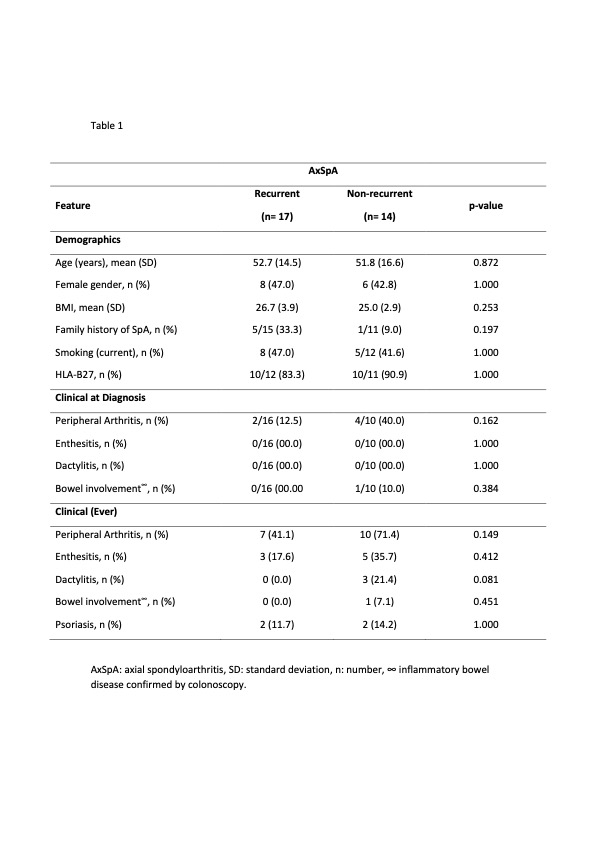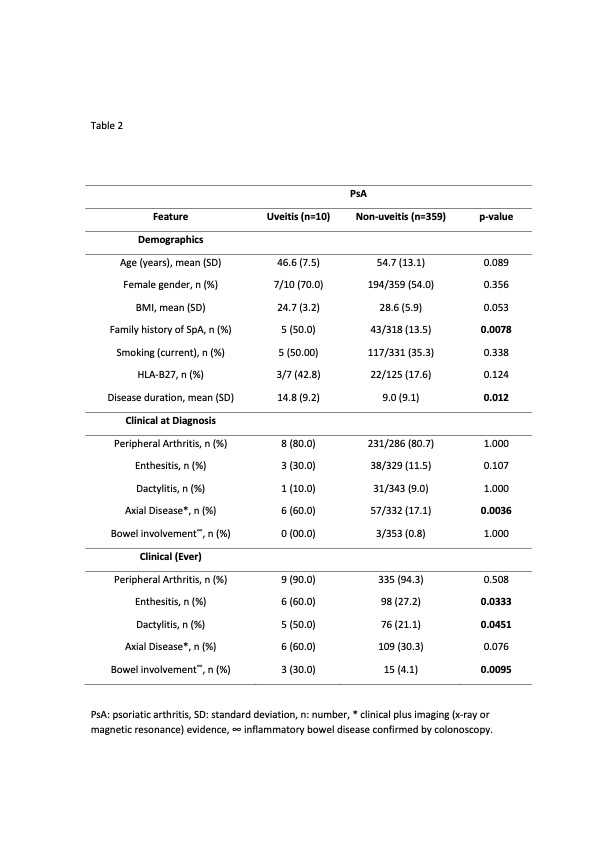Session Information
Session Type: Poster Session A
Session Time: 9:00AM-11:00AM
Background/Purpose: Data are still scarce about risk factors predicting the occurrence and course of uveitis in spondyloarthritis (SpA). We aimed to examine associations between demographic, clinical, and/or laboratory characteristics of SpA with the occurrence and the course (including eye damage and recurrence rate) of uveitis.
Methods: Characteristics (at disease diagnosis and ever-present) from all SpA patients in 3 tertiary rheumatology-clinics (1/2018-1/2023) were retrospectively recorded. Comparisons were made between patients with and without uveitis, as well as between subjects with uveitis rate [episodes/year] above the median uveitis rate in the whole cohort and those without persistent uveitis. In multivariable models, age, gender, and variables that were statistically significant in univariate analyses were included.
Results: 264 AxSpA and 369 PsA patients were enrolled. In AxSpA, uveitis occurred in 11.7% and was associated (multivariable analysis) with HLA-B27 (OR = 4.15, 95% CI 1.16-14.80, p=0.028) and ever-present peripheral arthritis (OR 3.05 (1.10 – 8.41, p=0.031;) (Table 1). In PsA, uveitis was reported in 2.7% of patients and was associated with SpA family history (p=0.023; 6.35 (1.29-31.27), axial disease at diagnosis (p=0.038; 5.61 (1.01-28.69) and disease duration (. p=0.004; 1.12 (1.04-1.21) (Table 2). Median uveitis rate was 0.205 for AxSpA and 0.285 for PsA. No associations were found between those above the above rates and demographic/clinical/laboratory characteristics. Permanent vision damage was seen in 16.1% of AxSpA and 30% of PsA patients, all of them with recurrent uveitis.
Conclusion: Uveitis in SpA is associated with specific characteristics. Permanent eye damage is not rare, especially in those with recurrent uveitis.
To cite this abstract in AMA style:
Kougkas N, Magiouf K, Gialouri C, Evangelatos G, Pappa M, Mpitouli A, Iliopoulos A, Dimitroulas T, Karamanakos A, Dimouli A, Tektonidou M, Sfikakis P, Fragoulis G. Multicentre Study of Uveitis in Spondyloarthritis: Prevalence, Characteristics, and Prognosis [abstract]. Arthritis Rheumatol. 2023; 75 (suppl 9). https://acrabstracts.org/abstract/multicentre-study-of-uveitis-in-spondyloarthritis-prevalence-characteristics-and-prognosis/. Accessed .« Back to ACR Convergence 2023
ACR Meeting Abstracts - https://acrabstracts.org/abstract/multicentre-study-of-uveitis-in-spondyloarthritis-prevalence-characteristics-and-prognosis/


